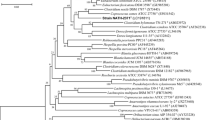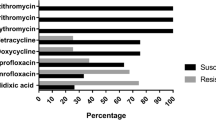Abstract
ThermotolerantCampylobacter strains isolated from dog feces were characterized by phenotypical tests, DNA base composition, and DNA-DNA-hybridization. Out of 98 strains, 63 were catalase negative or weakly reacting (CNW); they were found in diarrheic as well as in healthy dogs. The CNW strains were all nalidixic-acid sensitive, hippurate negative, and grew at 42°C but not at 25°C. Seven strains were further investigated. They were sensitive to 2,3,5-triphenyl-tetrazolium chloride, reduced nitrate, and produced H2S in the lead acetate test but not in triple-sugar-iron agar. The mol% G+C for five CNW isolates ranged from 35.2–35.8, which is higher than reported for any thermotolerantCampylobacter species. The strains also formed a well-delimitated DNA homology group with 80% or more intragroup relatedness and about 40% related toC. coli andC. jejuni.
Similar content being viewed by others
Literature Cited
Blaser, M. J., Cravens, J., Powers, B. W., Wang, W. L. 1978.Campylobacter enteritis associated with canine infection. LancetII:979–981.
Blaser, M. J., LaForce, F. M., Wilson, N. A., Wang, W. L. 1980. Reservoirs for human campylobacteriosis. The Journal of Infectious Diseases141(5):665–669.
Brenner, D. J., Fanning, G. R., Johnson, K. E., Citarella, R. V., Falkow, S. 1969. Polynucleotide sequence relationships among members of the Enterobacteriaceae. Journal of Bacteriology98:637–650.
Brenner, D. J., Fanning, G. R., Rake, A. V., Johnson, K. E. 1969. Batch procedure for thermal elution of DNA from hydroxyapatite. Analytical Biochemistry28:447–459.
Bruce, D., Zochowski, W., Fleming, G. A. 1980.Campylobacter infections in cats and dogs. Veterinary Record107:200–201.
Butzler, J. P., Dekeyser, P., Detrain, M., Dehaen, F. 1973.Related Vibrio in stools. The Journal of Pediatrics82(3):493–495.
Cowan, S. T. 1974. Cowan and Steel's manual for the identification of medical bacteria. Cambridge: University Press.
Dekeyser, P., Gossuin-Detrain, M., Butzler, J. P., Sternon, J. 1972. Acute enteritis due torelated Vibrio: first positive stool cultures. The Journal of Infectious Diseases125(4):390–393.
Ferreira, M.C.S., Ribeiro, V.L.S., Ricciardi, I.D. 1979.Campylobacter, dogs and human enteritis. Veterinary Record105:451.
Harvey, S. M. 1980. Hippurate hydrolysis byCampylobacter fetus. Journal of Clinical Microbiology11:435–437.
Hastings, D. H. 1978.Campylobacter enteritis in pets. LancetII:1249–1250.
Hosie, B. D., Nicholson, T. B., Henderson, D. B., 1979.Campylobacter infections in normal and diarrhoeic dogs. Veterinary Record105:80–81.
Hwang, M., Ederer, G. M. 1975. Rapid hippurate hydrolysis method for presumptive identification of group B streptococci. Journal of Clinical Microbiology1:114–115.
Kovács, N. 1956. Eine vereinfachte Methode zum Nachweis der Indolbildung durch Bakterien. Zeitschrift für Immunitätsforschung55:311–315.
Lawson, G. H. K., Leaver, J. L., Pettigrew, G. W., Rowland, A. C. 1981. Some features ofCampylobacter sputorum subsp.mucosalis subsp. nov., nom. rev. and their taxonomic significance. International Journal of Systematic Bacteriology31(4):385–391.
Leaper, S., Owen, R. J. 1981. Identification of catalaseproducingCampylobacter species based on biochemical characteristics and on cellular fatty acid composition. Current Microbiology6:31–35.
Leuchtefeld, N. W., Wang, W.-L. L. 1982. Hippurate hydrolysis by and triphenyltetrazolium tolerance ofCampylobacter fetus. Journal of Clinical Microbiology15:137–140.
Lindqvist, B., Kjellander, J., Kosunen, T. 1978.Campylobacter enteritis in Sweden. British Medical JournalI:303.
Mandel, M., Igambi, L., Bergendahl, J., Dodson, M. L., Jr., Scheltgen, E. 1970. Correlation of melting temperature and cesium chloride buoyant density of bacterial deoxyribonucleic acid. Journal of Bacteriology101:333–338.
Owen, R. J., Leaper, S. 1981. Base composition, size and nucleotide sequence similarities of genome deoxyribonucleic acids from species of the genusCampylobacter. FEMS Microbiology Letters12:395–400.
Prescott, J. F., Bruin-Mosch, C. W. 1981. Carriage ofCampylobacter jejuni in healthy and diarrheic animals. American Journal of Veterinary Research42(1):164–165.
Sandstedt, K., Wierup, M. 1980/1981. Concomitant occurrence ofCampylobacter andparvovirus in dogs with gastroenteritis. Veterinary Research Communications4:271–273.
Skirrow, M. B. 1981.Campylobacter enteritis in dogs and cats: a “new” zoonosis. Veterinary Research Communications5(1):13–19.
Skirrow, M. B., Benjamin, J. 1980. Differentiation of enteropathogenicCampylobacter. Journal of Clinical Pathology33:1122.
Smibert, R. M. 1974. GenusCampylobacter Sebald and Véron 1963, pp. 207–212. In: Buchanan R. E., Gibbons, N. E. (eds.), Bergey's manual of determinative bacteriology, 8th ed. Baltimore: Williams & Wilkins.
Tanner, A. C. R., Badger, S., Lai, C.-H., Listgarten, M. A., Visconti, R. A., Socransky, S. S. 1981.Wolinella gen. nov.,Wolinella succinogenes (Vibrio succinogenes Wolin et al.) comb. nov., and description ofBacteroides gracilis sp. nov.,Wolinella recta sp. nov.,Campylobacter concisus sp. nov., andEikenella corrodens from humans with periodontal disease. International Journal of Systematic Bacteriology31(4):432–445.
Tereba, A., McCarthy, B. J. 1973. Hybridization of125I-labeld ribonucleic acid. Biochemistry12:4675–4679.
Véron, M., Chatelain, R. 1973. Taxonomic study of the genusCampylobacter Sebald and Véron and designation of the neotype strain for the type speciesCampylobacter fetus (Smith and Taylor) Sebald and Véron. International Journal of Systematic Bacteriology23:122–134.
Walder, M. 1982. Epidemiology ofCampylobacter enteritis. Scandinavian Journal of Infectious Diseases14:27–33.
Author information
Authors and Affiliations
Rights and permissions
About this article
Cite this article
Sandstedt, K., Ursing, J. & Walder, M. ThermotolerantCampylobacter with no or weak catalase activity isolated from dogs. Current Microbiology 8, 209–213 (1983). https://doi.org/10.1007/BF01579548
Issue Date:
DOI: https://doi.org/10.1007/BF01579548




